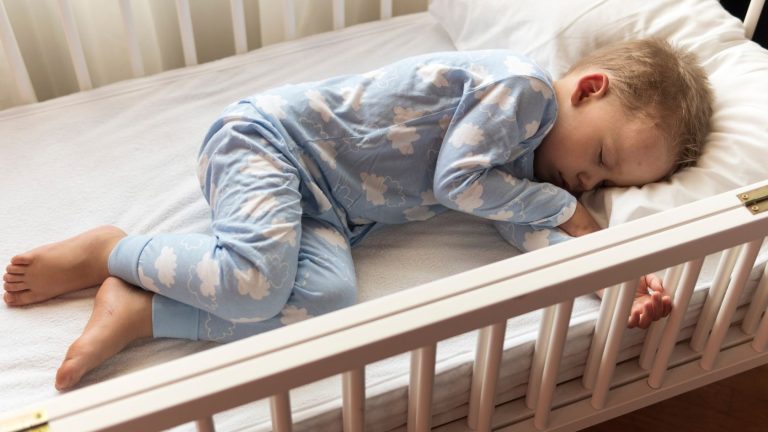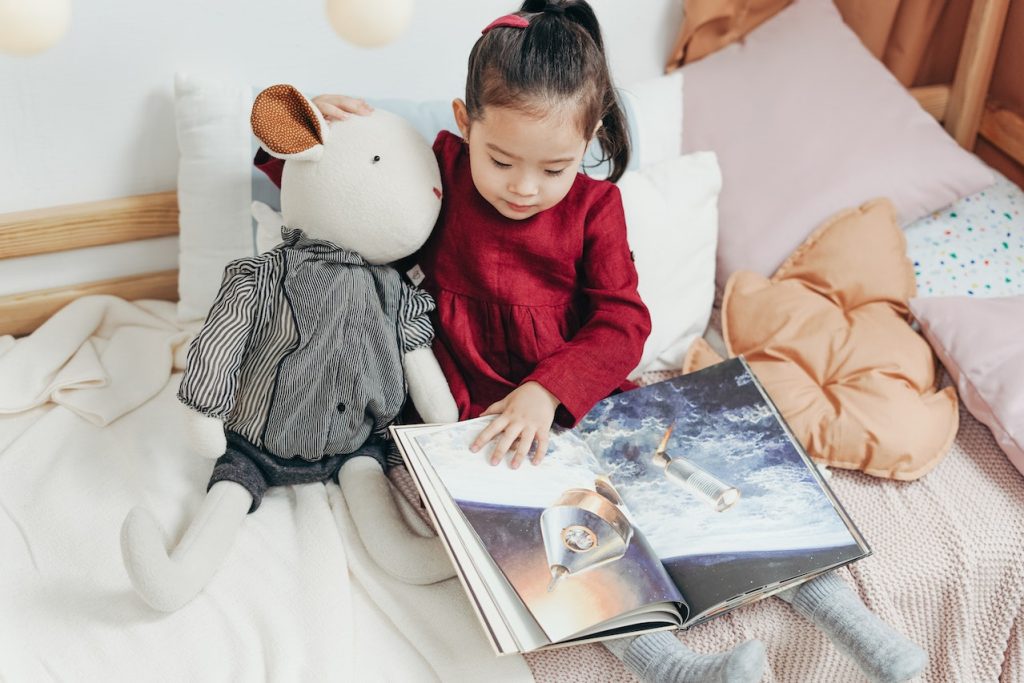
From Crib To Comfort: Navigating the Crib to Toddler Bed Transition With Ease
- Created:
1. 9. 2023 - Updated:
10. 1. 2024
Fact:
Your baby cannot sleep in a crib forever. As it grows, its sleep needs will evolve, and the crib will no longer be able to meet it. As such, it necessitates the switch to a toddler bed.
Now:
Transitioning to a toddler bed is a big step, and timing is important. If done too fast, your toddler will struggle to adapt to the change.
Lucky for you:
We have all the information you need to help make this transition to a toddler bed as natural as possible.
Let’s begin!
Benefits of Transitioning to a Toddler Bed
Get this:
Your toddler will most likely transition to a bed at about 2 to 3 years of age, according to the Nationwide Children’s Hospital.
Usually, you can tell that it’s time for a transition when your child is too big for the crib and can climb out of it.
Thus:
A change is in order if your toddler is about 3 feet or 35 inches tall.
Now:
While you may hesitate to change their sleeping space, you must prioritize their comfort. Let’s see some benefits of transitioning to a toddler bed below:
1. Increased Safety
Safety is one of the biggest reasons for transitioning to a toddler bed. When your toddler becomes more active, and the crib rail is lower than their chest, they’ll easily climb out of the crib. And certainly, it’s a cause for concern.
On the bright side:
Toddler beds are designed with much lower side rails and safety guards than cribs are. This reduces the chances of your toddler getting hurt in or out of bed.
2. An Easier Transition to a Full-Size Bed
Your toddler would need to move to a full-size childbed. And making that jump from a crib might be too steep.
Transitioning first to a toddler bed could be a stepping stone to moving to a regular bed. This makes that final move more natural and less overwhelming for your toddler.
3. Promotes Independence
Now:
Your child has been used to being in a crib, likely in your room or within earshot. But, with growth and maturity, there is a need for increased independence.
Moving them to a toddler bed allows them to choose when to get in and out of bed. This newfound autonomy helps them mature over time.
4. Space Efficiency
Compared to a crib, toddler beds have a smaller footprint. Consequently, it’s best to switch to a toddler bed for your child if you have limited space in your house or apartment. This is especially important if your child’s room is small or shared with a sibling.
5. Allows More Room for Growth
You see:
A crib was the right choice when your toddler was only a few months old. But now that they are much bigger, there is a need for change.
Following this:
Your toddler’s sleep space should have enough room and comfort for movement during the night. Else, they could struggle to sleep and have their growth stunted.
Therefore:
Transitioning to a toddler bed is beneficial for your child as it provides more sleep space, aiding their growth.

Choosing the Right Toddler Bed
Truthfully, identifying the perfect toddler bed can be tricky with the different types and models available. But with the tips I’ve put together, you’ll have no worries choosing the right toddler bed for your child.
Let’s see some of them below:
1. Ensure the Bed is Safe For Your Child
Listen:
Safety must top your priority list when searching for the right toddler bed.
Why?
Toddlers are explorers! So, at times, you might find your child rolling out of bed while asleep.
As such:
To prevent your toddler from harm, consider getting them a bed with a low platform and guardrails around it. A good option for this is the standard toddler bed with dimensions 28″ x 52″.
2. Consider the Size and Comfortability of the Bed
Generally:
Toddlers love having space to move around, whether asleep or not.
So;
While choosing the bed, you should consider getting one that is wide and comfortable for your baby.
For example:
You could try the extended toddler bed, which is similar to the standard toddler bed but wider. Its 31″ x 70″ dimension gives your baby the space and comfort they need.
Another good option for space is the twin-sized bed with measurements 38″ x 75.”
3. Look Out for Beds Made With Non-Toxic Material
Here’s the thing:
Sometimes, you might find your toddler chewing on the bedframe or rubbing their palms on the edges of the bed. So, if any toxic materials are on the bed, they will get to your child.
To avoid this:
Ensure the beds are devoid of toxic paints or materials. Essentially, you should consider beds with well-treated wooden frames and without coating. Make sure the frame is eco-friendly so your child is completely out of harm’s way.
See the table describing the types of toddler beds and their respective pros and cons:
| Type of Toddler Bed | Pros | Cons |
| Standard toddler bed | It is small and can fit into the child’s room easily.It has a low base and guardrails, thus preventing your child from serious injury. | Toddlers quickly transition from it as they grow.It’s less cost-efficient since the child can easily outgrow it. |
| Extended toddler bed | It’s wide, so it makes your baby more comfortable and is suitable for bed sharing.It has guardrails that help keep your toddler safe. | It might not fit into the child’s room due to its size. |
| Twin-sized bed | It is spacious to allow for comfort.Due to its size, your child doesn’t have to switch beds frequently. | Cost of bedding is higher.It doesn’t come with guardrails, so you’d have to install them. |

Preparing for the Transition
Get this:
When preparing for this transition, you must take note of your child’s readiness. A change isn’t necessary if they are comfortable and not climbing out of their crib.
As such, the transition to a toddler bed must be timely and correct. You can tell their readiness by paying attention to their needs and cues. And it’s absolutely easy!
Thankfully:
We will be sharing some tips to help you prepare for this transition:
1. Time It Right
As necessary as this transition is, you must be careful not to begin too early. You must look for signs of readiness, such as your toddler being too big for the crib and climbing out of it. Conversely, initiating the transition when your child is emotionally and physically prepared makes it successful.
2. Involve Your Toddler in the Process
Involving your child in the decision-making in the transition makes them feel involved and excited about the move. You can allow them to select sheets, blankets, or even a special comfort item, such as a stuffed animal, to create enthusiasm.
Doing this helps foster a sense of ownership and independence for your toddler, fostering their development.
3. Don’t Rush the Transition
Like every transition, this one may not be smooth. To ease it, you should do it gradually.
You can start by letting your toddler nap in bed while sleeping in the crib. This could help them get used to sleeping there before transitioning to overnight sleep at their own pace.
4. Maintain a Familiar Sleep Routine
With changes in your toddler’s sleep environment, keeping all other sleep factors constant is advisable. Doing this will increase the chances of your toddler adapting to this transition.
Furthermore:
Continuing the established sleep routine serves as a sleep cue for your child. Activities like singing or playing lullabies, reading bedtime stories, and using white noise are good examples.
Common Challenges During the Transition
Now:
The move to a toddler bed is both necessary and desirable. But that doesn’t mean that it comes without its perils. Transitioning your baby at the right time is already a hurdle to cross, and it is not the only one.
We have a whole list of them:
1. Resistance to Change
A possible challenge is your toddler refusing to sleep in their new bed. After spending most of their life sleeping in a crib, a mattress could be strange and unsettling to them.
To solve this challenge, you must be patient and tactful. Exposing your child to its new sleep area by encouraging it to play and nap there helps.
2. Sleep Regression
Changing your toddler’s sleep area could lead to sleep regression. It could have difficulty falling asleep or waking up during night sleep.
To combat this, you can stick to the sleep routine that has been in use since they slept in a crib. Doing this helps create a sleep cue and establish uninterrupted sleep.
3. Development of Fears
It is possible that your toddler could develop fears due to the change to its sleep environment. Fear of being alone, falling from the bed, or the dark could cause them to develop bedtime anxiety.
So:
Don’t be dismissive of your child’s concerns but address these fears with patience, understanding, and empathy.
For instance, putting a nightlight near the bed could help ease their fear of the dark, while installing safety guards could soothe their fear of falling.
Final Tip: Annie Baby Monitor – Your Watchful Companion in the Nursery
Watching over your little one when they start sleeping on their own is important.
You can easily do that by placing a monitor in their nursery. With Annie’s real-time video and audio monitoring, as well as cry and motion detection, you can always stay connected with your child, which will give you peace of mind and give you peace of mind.

Looking for a top-notch baby monitor? Look no further than Annie Baby Monitor. It’s the perfect solution for keeping tabs on your little one. Check it out now.
Conclusion
In summary:
Transitioning to a toddler bed is necessary for your child’s development. It happens when your child is about 2 years old, although it should not happen before they are ready.
Now:
This transition is beneficial in the following ways:
- Promoting independence
- Increasing safety
- Allowing more room for growth
- Easing the transition to a full-sized bed
- Space efficiency
Choosing the right toddler bed affects the transition process. When selecting it, you should consider factors such as safety, durability, comfort, and functionality.
As with any transition, there would be some hiccups. But you can manage the transition by timing it right and making it gradual. Maintaining a familiar sleep routine and involving your toddler in decision-making also help to ease it.
Finally:
I hope this article has answered your questions about transitioning to a toddler bed. Feel free to share your tips and experiences with the transition in the comment section.
FAQ: Transition to Toddler Bed
The best time to transition your child to a toddler bed is typically between 2 and 3 years of age. However, this depends on their individual development and readiness. Babies often show signs like climbing out of their cribs to indicate this readiness.
To transition to a toddler bed smoothly, gradually introduce the new bed during daytime naps and maintain a consistent bedtime routine for stability. Also, create a familiar sleep environment with their favorite items from the crib. In addition, be patient and offer positive reinforcement to help your child adjust to their new sleep environment.
To ensure your child’s safety, use bed rails to prevent falls and position the bed away from hard surfaces. Secure any furniture or heavy objects that could pose a danger and remove choking hazards from the toddler bed. Additionally, use a baby monitor to keep an eye on your child during the night and ensure they are sleeping safely.






